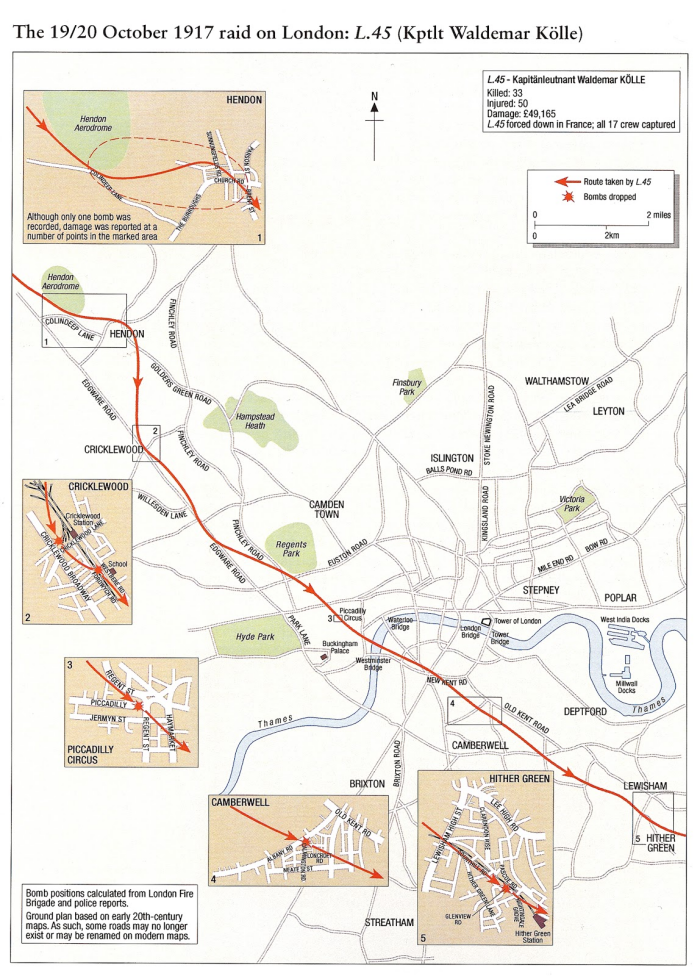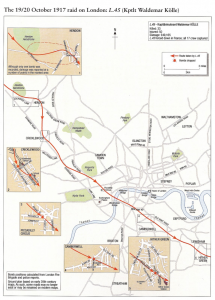When a Zeppelin flew over Kilburn
The Germans began Zeppelin airship attacks in 1915. At first people came out to stare in wonder at these huge flying machines, but became more cautious as the bombs started to fall.

On the 19 October 1917 a group of 13 airships left Germany to attack the Northern industrial cities of Liverpool, Manchester and Sheffield. Climbing to 16,000 feet they encountered extremely strong winds which forced them off course and made it very difficult for the commanders to establish their position. Lt. Waldemar Kolle was in L.45 aiming for Sheffield, but he found he was being blown rapidly south. He dropped a number of bombs on Northampton, but around 23.30 the crew became aware of a large number of lights and realised they were over London. Kolle dropped several bombs which damaged the Grahame-White Aviation Company in Hendon. Continuing south-east, he dropped further bombs which landed near Cricklewood Station.
These Zeppelin were a new class of airship which flew so high that British fighters and anti aircraft guns couldn’t reach them. Some of the crew got frostbite and others suffered from altitude sickness. The height and the thin cloud cover also meant that people on the ground couldn’t see or hear the airship and this attack became known as ‘the silent raid’.
Flying over the Kilburn High Road and St Johns Wood towards central London, the Zeppelin crew dropped bombs at random: but the effects were devastating. The first fell close to Piccadilly Circus where a huge 660lb bomb smashed the front of department store Swan and Edgar’s and caused further damage in Regents Street, Jermyn Street and Shaftesbury Avenue. Flying glass and shrapnel cut down 25 people and seven died. L.45 continued over South London bombing Camberwell and Hither Green, killing another 20 people.
Despite the strong winds, Lt. Kolle flew his Zeppelin across the Channel to France and with only two engines working and short of fuel, landed in Southern France. He set the ship on fire before surrendering to a group of French soldiers. This proved to be last Zeppelin attack on London; subsequent raids were carried out by Gotha and Staaken Giant bombers.

The Staaken Giant Bomber which took over from the Zeppelin airships at the end of the War
The map and information come from an excellent book by Ian Castle, London 1914-17: The Zeppelin Menace, Osprey Publishing, 2008. ISBN 978-1-84603-245-5
Marianne owns a postcard, which will have been printed in thousands. An inky black sky is pierced by the beams of search lights which light up a small, elongated white oval, meant to be a Zeppelin. The date ‘Wednesday 8 September 1915’ is printed bottom right, when London experienced its most severe Zeppelin raid, almost all the damage inflicted by just one Zeppelin, the L13. Bombs were dropped on Golders Green and Central London as far as Liverpool Street Station. So it was an event to remember. The legend ‘Zeppelin Raid as seen at …’ (blank) appears bottom left. So anyone buying the card as a souvenir could send it to a friend or relative, filling in the blank with their chosen location.



Comments
When a Zeppelin flew over Kilburn — No Comments
HTML tags allowed in your comment: <a href="" title=""> <abbr title=""> <acronym title=""> <b> <blockquote cite=""> <cite> <code> <del datetime=""> <em> <i> <q cite=""> <s> <strike> <strong>